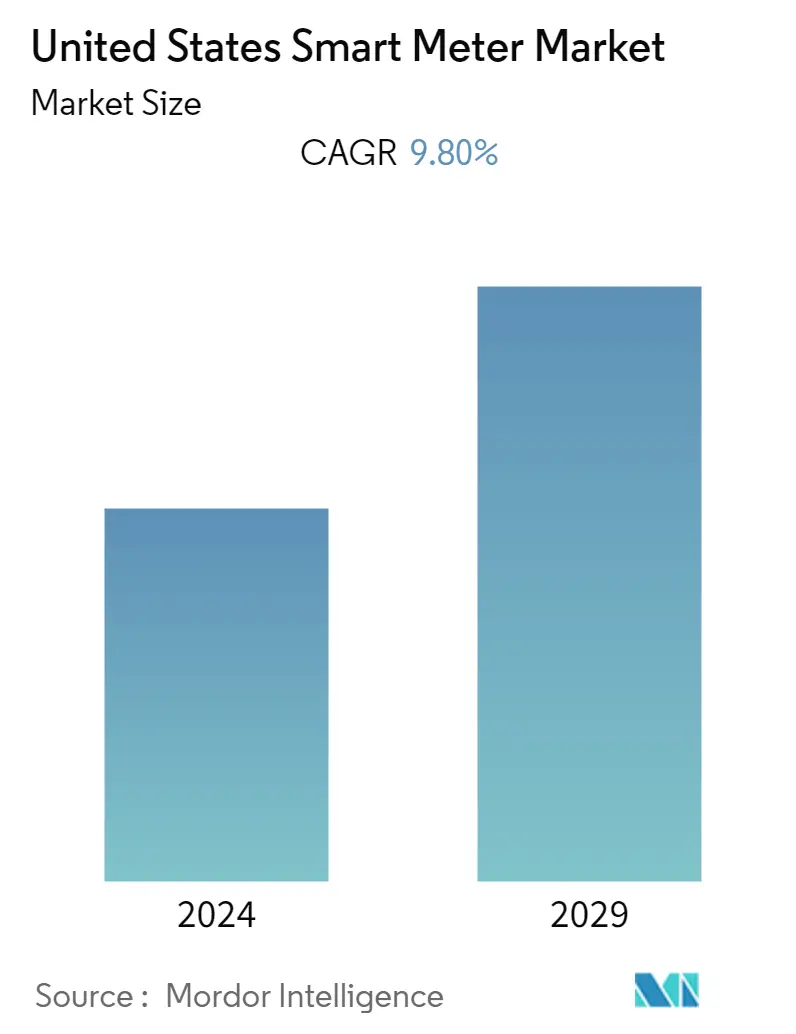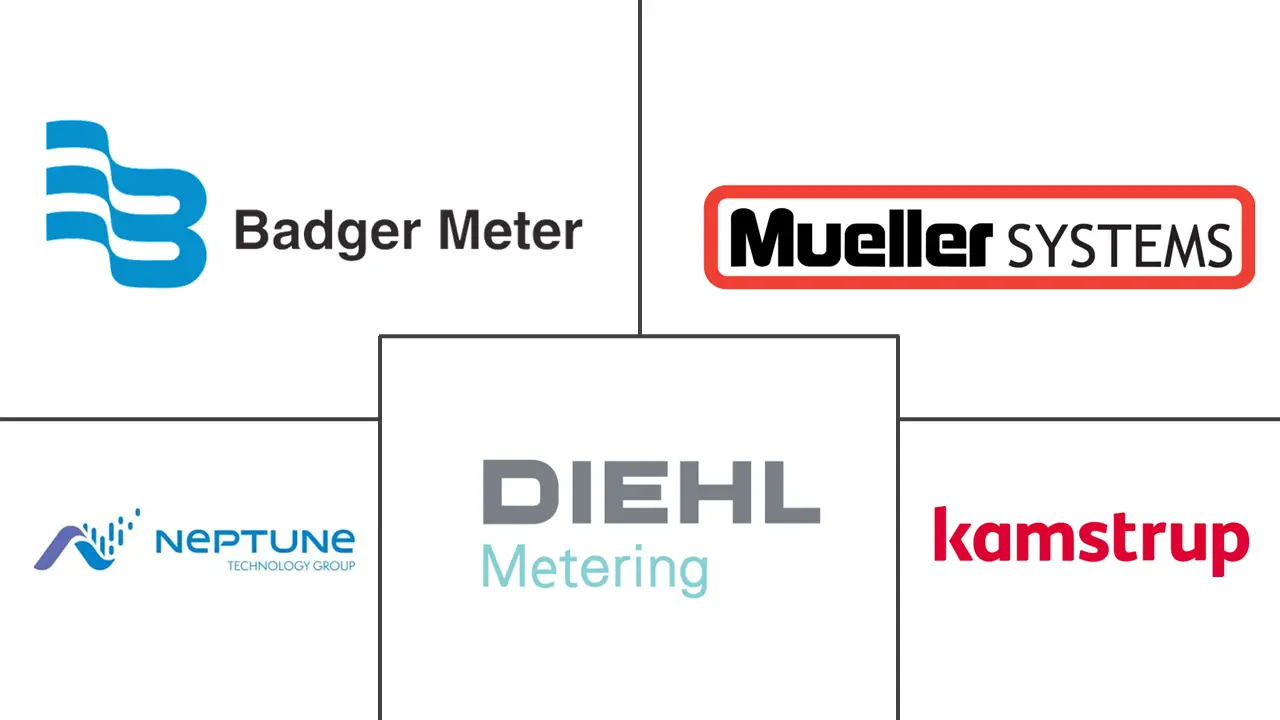Market Size of United States Smart Meter Industry

| Study Period | 2019 - 2029 |
| Base Year For Estimation | 2023 |
| Forecast Data Period | 2024 - 2029 |
| Historical Data Period | 2019 - 2022 |
| CAGR | 9.80 % |
| Market Concentration | Medium |
Major Players
*Disclaimer: Major Players sorted in no particular order |
US Smart Meter Market Analysis
The United States smart meter market was expected to grow at a CAGR of 9.8% for the forecast period (2022-2027). Implementation of different government regulations mandating the installation of smart meters and increased investments in smart grid technology, coupled with growing consumer awareness about the benefits of installing smart meters, are the major factors fuelling the market growth.
- As utilities seek more efficient, reliable, and secure ways to manage energy generation, transmission, and distribution, the smart grid has emerged as an effective approach to aligning the supply of energy in a given market with demand while reducing waste. The smart meter is one of the most important devices used in the smart grid and has two-way communication capability between electric utilities and customers. In recent years, increasing investments in smart grid projects along with different government policies, particularly mandates and fiscal incentives, are among the key drivers of market adoption of smart meters in the United States.
- For instance, in September 2021, the U.S. Department of Agriculture announced that it would invest USD 464 million to build or improve renewable energy infrastructure and help rural communities, agricultural producers, and businesses lower energy costs in 48 states and Puerto Rico. The USDA financed USD 335 million of these investments through the Electric Loan Program, including USD 102 million for investments in smart grid technology.
- Further, consumer demand for smart and green services continues to grow and they are now seeking personalized services that enable them to optimize usage and reduce bills. Through smart meter data, utilities are able to help customers reduce energy costs, which is another factor driving the growth of the market.
- At the start of the Covid-19, the primary impact faced by many smart meter manufacturers was supply problems, owing to halted production. Moreover, owing to lockdown measures, demand for residential, commercial, and industrial use of smart meters also decreased. However, with the ease of the pandemic-related lockdowns, manufacturing and supply of smart meters are returning to normal levels, with many manufacturers starting to witness a recovery in sales.
- However, the initial investment involved in setting up smart meter infrastructure is usually much higher as compared to traditional meters, and it also takes a longer time to achieve high returns on investments. The requirement for huge capital poses a significant challenge to both energy consumers and utility providers, which acts as a market restraint.
US Smart Meter Industry Segmentation
A smart meter is a digital device that utilizes two-way communication to connect utilities and consumers and support demand response and distributed generation. The device obtains information from the end users' load devices and measures the energy consumption of the consumers, and then provides added information to the utility company. In addition to reporting the energy usage of the consumer, the smart meters can also inform the utility immediately if there is a power outage in the consumer's area.
| By Type | |
| Smart Gas Meters | |
| Smart Water Meters | |
| Smart Electricity Meters |
| By End-User | |
| Commercial | |
| Industrial | |
| Residential |
United States Smart Meter Market Size Summary
The United States smart meter market is experiencing significant growth, driven by government regulations mandating installations and increased investments in smart grid technology. The smart grid, which enhances the efficiency and reliability of energy management, relies heavily on smart meters that facilitate two-way communication between utilities and consumers. This technology is gaining traction as it aligns energy supply with demand, reduces waste, and helps consumers optimize their energy usage and costs. The market is further bolstered by consumer demand for smart and green services, as well as favorable government policies that provide incentives for smart meter adoption. Despite challenges such as high initial investment costs and the need for substantial capital, the market continues to expand, supported by recovery in manufacturing and supply post-pandemic.
In the residential sector, the demand for smart meters is particularly strong due to increased power consumption from home appliances and the need for enhanced grid resiliency. Smart meters also play a crucial role in integrating distributed energy resources and supporting energy storage and EV charging facilities. Government initiatives aimed at improving meter accuracy and transparency in energy consumption are further propelling market growth. The competitive landscape of the smart meter market in the United States is characterized by strategic collaborations among key players, who are continuously innovating and expanding their offerings to capture a larger market share. These developments are expected to provide consumers with more opportunities to manage their electricity consumption efficiently, leading to significant long-term savings.
United States Smart Meter Market Size - Table of Contents
-
1. MARKET INSIGHTS
-
1.1 Market Overview
-
1.2 Industry Attractiveness-Porter's Five Force Analysis
-
1.2.1 Bargaining Power of Suppliers
-
1.2.2 Bargaining Power of Consumers
-
1.2.3 Threat of New Entrants
-
1.2.4 Intensity of Competitive Rivalry
-
1.2.5 Threat of Substitutes
-
-
1.3 Industry Value Chain Analysis
-
1.4 Impact of COVID-19 Outbreak on the Industry
-
-
2. MARKET DYNAMICS
-
2.1 Market Drivers
-
2.1.1 Higher Consumer Awareness and Government Regulations Mandating the Installation of Smart Meters
-
2.1.2 Increased Investments in Smart Grid Projects
-
2.1.3 Investments in Smart City Developments
-
-
2.2 Market Challenges
-
2.2.1 Higher Costs, Security Concerns and Integration Difficulties with the Installation of Smart Meters
-
-
2.3 AMI integration with customer information system, distribution management system, billing systems, etc.
-
-
3. MARKET SEGMENTATION
-
3.1 By Type
-
3.1.1 Smart Gas Meters
-
3.1.2 Smart Water Meters
-
3.1.3 Smart Electricity Meters
-
-
3.2 By End-User
-
3.2.1 Commercial
-
3.2.2 Industrial
-
3.2.3 Residential
-
-
United States Smart Meter Market Size FAQs
What is the current United States Smart Meter Market size?
The United States Smart Meter Market is projected to register a CAGR of 9.80% during the forecast period (2024-2029)
Who are the key players in United States Smart Meter Market?
Badger Meter Inc., Mueller Systems LLC, Diehl Metering US, Kamstrup and Neptune Technology Group Inc. are the major companies operating in the United States Smart Meter Market.

